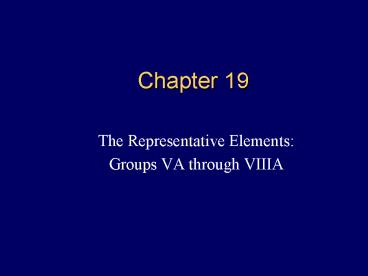The Representative Elements: - PowerPoint PPT Presentation
1 / 8
Title:
The Representative Elements:
Description:
Trends of the Periodic Table. Electronegativity Decreases. Ionization energy decreases ... Properties of the Transition Metals. Element Sc Ti V Cr Mn Fe Co Ni Cu Zn ... – PowerPoint PPT presentation
Number of Views:125
Avg rating:3.0/5.0
Title: The Representative Elements:
1
Chapter 19
- The Representative Elements
- Groups VA through VIIIA
2
Electronegativity Increases
Ionization energy Increases
Electron affinity Increases
Atomic size Decreases
Metallic nature Decreases
Higher oxidation states of T.M. become more
stable
Electron affinity decreases
Electronegativity Decreases
Higher oxidation states less stable
Chemical activity Increases
Ionization energy decreases
Nonmetal trends all the same except chemical
activity decreases
Metallic nature Increases
Atomic size Increases
Trends of the Periodic Table
3
Properties of the Transition Metals
- Element Sc Ti V Cr Mn Fe Co Ni Cu Zn
- Ionization energy 631 658 651 653 759 717 760 736
745 906 - (kJ/mol)
- Electronegativity 1.3 1.5 1.6 1.6 1.5 1.8 1.8 1.8
1.9 1.6 - Atomic radius (pm) 144 132 122 119 118 117 116 115
118 121 - 2 ionic radius (pm) -- 94 88 89 80 74 72 69 72
74 - 3 ionic radius (pm) 73 67 64 62 65 65 61 60 -- --
- Density (g/cm3) 3.00 4.51 6.11 7.19 7.4 7.87 8.92
9.91 8.94 7.135 - Melting point (oC) 1541 1660 1890 1857 1244 1525 1
495 1453 1083 420 - Boiling point (oC) 2831 3287 3380 2672 1962 2750 2
870 2732 2567 907
4
(No Transcript)
5
Aqueous species of the first transition metal
series
- Sc Ti V Cr Mn Fe Co Ni Cu Zn
- d0 Sc3 TiO2 VO2 CrO42- MnO4-
- d1 Ti3 VO2 H3CrO4 MnO42-
- d2 Ti2 V3 (Cr4) MnO3- FeO42-
- d3 V2 Cr3 MnO2
- d4 Cr2 Mn3 (FeIV) NiO42-
- d5 Mn2 Fe3 CoO2
- d6 Fe2 Co3
- CoL6n NiO2
- d7 Co2
- CoL6m
- d8 (Co) Ni2 CuO
- d9 Cu3
- d10 Cu Zn2
6
(No Transcript)
7
(No Transcript)
8
(No Transcript)































